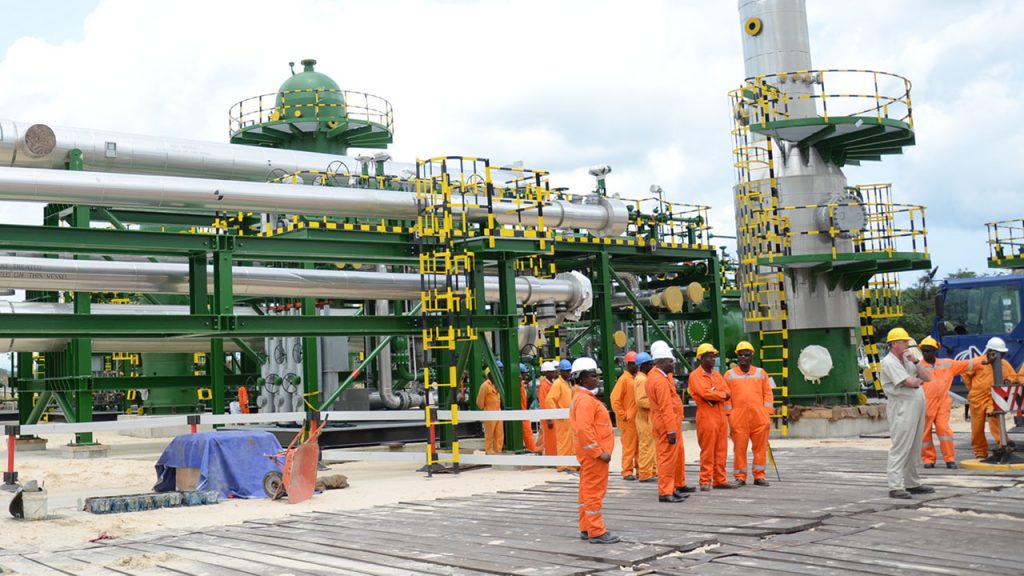Daily crude oil production in Nigeria dropped by 38,000 barrels in July to 1.37 million barrels, a new report by the Organisation of Petroleum Exporting Countries showed on Wednesday.
The oil cartel, in its Monthly Oil Report for August, said the total crude oil production by the 13-member group averaged 23.17 million bpd in July 2020, higher by 0.98 million bpd month-on-month, according to secondary sources.
OPEC and its allies, known as OPEC+, agreed in April to an output cut to offset a slump in demand and prices caused by the coronavirus crisis.
They decided to cut supply by a record 9.7 million bpd for May and June but the deal was extended in July by one month.
The group said any member that did not implement 100 per cent of its production cuts in May and June would make extra reductions from July to September to compensate for their failings.
Under the April deal, Nigeria was expected to cap its production at 1.41 million bpd in May and June but the country overproduced during the period.
In July, the country said it was ready to make additional oil output cuts from July to September to compensate for producing more than its quota in May and June.
OPEC said Nigeria’s production level, based on secondary sources, was 1.49 million bpd in July, but the country put its production figure at 1.37 million bpd.
The group uses secondary sources to monitor oil outputs, but also publishes a table of figures submitted by its member countries.
OPEC’s cautious optimism in July that the global economy was rebounding faster than expected from the coronavirus pandemic has dimmed, just as the group and its allies are easing off their historic production cuts, according to S&P Global Platts.
OPEC, on Wednesday, issued its latest oil market forecast, revising down its projection of global demand by almost 100,000 bpd for both 2020 and 2021.
At the same time, non-OPEC supply is expected to increase more than the organisation had previously forecast.
The outlook puts pressure on members of the OPEC+ alliance, in their role as the oil market’s swing producers, to remain disciplined if they want to speed a further recovery in oil prices.
The OPEC+ cuts of 9.7 million bpd have been scaled back to 7.7 million bpd from August through the end of the year and will relax even further to 5.8 million bpd from January 2021 through April 2022.
Credit:Punch
Daily crude oil production in Nigeria dropped by 38,000 barrels in July to 1.37 million barrels, a new report by the Organisation of Petroleum Exporting Countries showed on Wednesday.
The oil cartel, in its Monthly Oil Report for August, said the total crude oil production by the 13-member group averaged 23.17 million bpd in July 2020, higher by 0.98 million bpd month-on-month, according to secondary sources.
OPEC and its allies, known as OPEC+, agreed in April to an output cut to offset a slump in demand and prices caused by the coronavirus crisis.
They decided to cut supply by a record 9.7 million bpd for May and June but the deal was extended in July by one month.
The group said any member that did not implement 100 per cent of its production cuts in May and June would make extra reductions from July to September to compensate for their failings.
Under the April deal, Nigeria was expected to cap its production at 1.41 million bpd in May and June but the country overproduced during the period.
In July, the country said it was ready to make additional oil output cuts from July to September to compensate for producing more than its quota in May and June.
OPEC said Nigeria’s production level, based on secondary sources, was 1.49 million bpd in July, but the country put its production figure at 1.37 million bpd.
The group uses secondary sources to monitor oil outputs, but also publishes a table of figures submitted by its member countries.
OPEC’s cautious optimism in July that the global economy was rebounding faster than expected from the coronavirus pandemic has dimmed, just as the group and its allies are easing off their historic production cuts, according to S&P Global Platts.
OPEC, on Wednesday, issued its latest oil market forecast, revising down its projection of global demand by almost 100,000 bpd for both 2020 and 2021.
At the same time, non-OPEC supply is expected to increase more than the organisation had previously forecast.
The outlook puts pressure on members of the OPEC+ alliance, in their role as the oil market’s swing producers, to remain disciplined if they want to speed a further recovery in oil prices.
The OPEC+ cuts of 9.7 million bpd have been scaled back to 7.7 million bpd from August through the end of the year and will relax even further to 5.8 million bpd from January 2021 through April 2022.
Credit:Punch
Daily crude oil production in Nigeria dropped by 38,000 barrels in July to 1.37 million barrels, a new report by the Organisation of Petroleum Exporting Countries showed on Wednesday.
The oil cartel, in its Monthly Oil Report for August, said the total crude oil production by the 13-member group averaged 23.17 million bpd in July 2020, higher by 0.98 million bpd month-on-month, according to secondary sources.
OPEC and its allies, known as OPEC+, agreed in April to an output cut to offset a slump in demand and prices caused by the coronavirus crisis.
They decided to cut supply by a record 9.7 million bpd for May and June but the deal was extended in July by one month.
The group said any member that did not implement 100 per cent of its production cuts in May and June would make extra reductions from July to September to compensate for their failings.
Under the April deal, Nigeria was expected to cap its production at 1.41 million bpd in May and June but the country overproduced during the period.
In July, the country said it was ready to make additional oil output cuts from July to September to compensate for producing more than its quota in May and June.
OPEC said Nigeria’s production level, based on secondary sources, was 1.49 million bpd in July, but the country put its production figure at 1.37 million bpd.
The group uses secondary sources to monitor oil outputs, but also publishes a table of figures submitted by its member countries.
OPEC’s cautious optimism in July that the global economy was rebounding faster than expected from the coronavirus pandemic has dimmed, just as the group and its allies are easing off their historic production cuts, according to S&P Global Platts.
OPEC, on Wednesday, issued its latest oil market forecast, revising down its projection of global demand by almost 100,000 bpd for both 2020 and 2021.
At the same time, non-OPEC supply is expected to increase more than the organisation had previously forecast.
The outlook puts pressure on members of the OPEC+ alliance, in their role as the oil market’s swing producers, to remain disciplined if they want to speed a further recovery in oil prices.
The OPEC+ cuts of 9.7 million bpd have been scaled back to 7.7 million bpd from August through the end of the year and will relax even further to 5.8 million bpd from January 2021 through April 2022.
Credit:Punch
Daily crude oil production in Nigeria dropped by 38,000 barrels in July to 1.37 million barrels, a new report by the Organisation of Petroleum Exporting Countries showed on Wednesday.
The oil cartel, in its Monthly Oil Report for August, said the total crude oil production by the 13-member group averaged 23.17 million bpd in July 2020, higher by 0.98 million bpd month-on-month, according to secondary sources.
OPEC and its allies, known as OPEC+, agreed in April to an output cut to offset a slump in demand and prices caused by the coronavirus crisis.
They decided to cut supply by a record 9.7 million bpd for May and June but the deal was extended in July by one month.
The group said any member that did not implement 100 per cent of its production cuts in May and June would make extra reductions from July to September to compensate for their failings.
Under the April deal, Nigeria was expected to cap its production at 1.41 million bpd in May and June but the country overproduced during the period.
In July, the country said it was ready to make additional oil output cuts from July to September to compensate for producing more than its quota in May and June.
OPEC said Nigeria’s production level, based on secondary sources, was 1.49 million bpd in July, but the country put its production figure at 1.37 million bpd.
The group uses secondary sources to monitor oil outputs, but also publishes a table of figures submitted by its member countries.
OPEC’s cautious optimism in July that the global economy was rebounding faster than expected from the coronavirus pandemic has dimmed, just as the group and its allies are easing off their historic production cuts, according to S&P Global Platts.
OPEC, on Wednesday, issued its latest oil market forecast, revising down its projection of global demand by almost 100,000 bpd for both 2020 and 2021.
At the same time, non-OPEC supply is expected to increase more than the organisation had previously forecast.
The outlook puts pressure on members of the OPEC+ alliance, in their role as the oil market’s swing producers, to remain disciplined if they want to speed a further recovery in oil prices.
The OPEC+ cuts of 9.7 million bpd have been scaled back to 7.7 million bpd from August through the end of the year and will relax even further to 5.8 million bpd from January 2021 through April 2022.
Credit:Punch
Daily crude oil production in Nigeria dropped by 38,000 barrels in July to 1.37 million barrels, a new report by the Organisation of Petroleum Exporting Countries showed on Wednesday.
The oil cartel, in its Monthly Oil Report for August, said the total crude oil production by the 13-member group averaged 23.17 million bpd in July 2020, higher by 0.98 million bpd month-on-month, according to secondary sources.
OPEC and its allies, known as OPEC+, agreed in April to an output cut to offset a slump in demand and prices caused by the coronavirus crisis.
They decided to cut supply by a record 9.7 million bpd for May and June but the deal was extended in July by one month.
The group said any member that did not implement 100 per cent of its production cuts in May and June would make extra reductions from July to September to compensate for their failings.
Under the April deal, Nigeria was expected to cap its production at 1.41 million bpd in May and June but the country overproduced during the period.
In July, the country said it was ready to make additional oil output cuts from July to September to compensate for producing more than its quota in May and June.
OPEC said Nigeria’s production level, based on secondary sources, was 1.49 million bpd in July, but the country put its production figure at 1.37 million bpd.
The group uses secondary sources to monitor oil outputs, but also publishes a table of figures submitted by its member countries.
OPEC’s cautious optimism in July that the global economy was rebounding faster than expected from the coronavirus pandemic has dimmed, just as the group and its allies are easing off their historic production cuts, according to S&P Global Platts.
OPEC, on Wednesday, issued its latest oil market forecast, revising down its projection of global demand by almost 100,000 bpd for both 2020 and 2021.
At the same time, non-OPEC supply is expected to increase more than the organisation had previously forecast.
The outlook puts pressure on members of the OPEC+ alliance, in their role as the oil market’s swing producers, to remain disciplined if they want to speed a further recovery in oil prices.
The OPEC+ cuts of 9.7 million bpd have been scaled back to 7.7 million bpd from August through the end of the year and will relax even further to 5.8 million bpd from January 2021 through April 2022.
Credit:Punch





